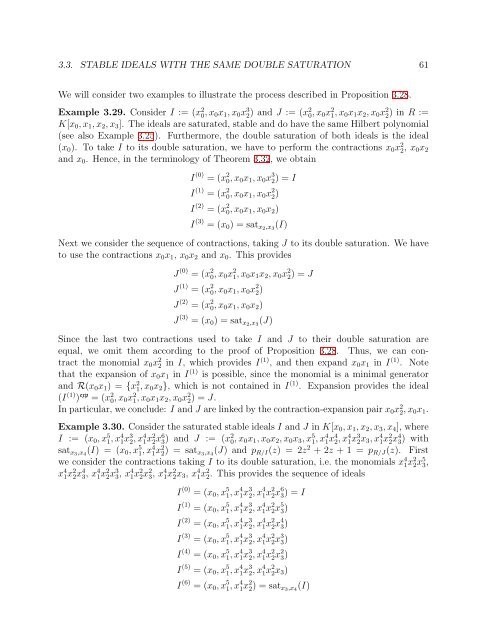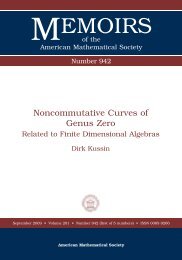60 CHAPTER 3. OPERATIONS ON STABLE IDEALS<strong>of</strong> R( ˜m 1 ) into the set <strong>of</strong> minimal generators <strong>of</strong> sat xn−1 ,x n(I). Hence, we can expand themonomial ˜m 1 in I (1) , which provides the ideal I (2) = (I (1) ) exp .Now, we proceed by induction on r. In the case r = 1, we have just proved that we can contractm ′ 1 in I, which provides I (1) , and then expand ˜m 1 in I (1) . Since I (1) = sat xn−1 ,x n(I) =sat xn−1 ,x n(J), the expansion <strong>of</strong> ˜m 1 in I (1) indeed provides the ideal I (2) = J.Let r > 1. Again by induction, we may assume that we have performed the contractionexpansionpairs(m ′ 1, ˜m 1 ), (m ′ 2, ˜m 2 ), . . . (m ′ i−1, ˜m i−1 ),which provide some ideal I (2i−2) (since we have proved above that we can perform thecontraction-expansion pair (m ′ 1, ˜m 1 )). We have to show that we can contract m ′ i in I (2i−2)and expand ˜m i in I (2i−1) = (I 2i−2 ) con . Since m ′ i is contractible in the ideal obtained byperforming the contractions m ′ 1, . . . , m ′ i−1 in I, it suffices to show that the expansions˜m 1 , . . . , ˜m i−1 did not hurt the condition for a contraction. Since we have m ′ i ≠ ˜m j for all1 ≤ j ≤ r, the monomial m ′ i · x n−1 cannot have been removed from the set <strong>of</strong> generatorsby any <strong>of</strong> the expansions performed, for an expansions removes only the monomial itself,which is expanded (Note: We only contract monomials with the last variable x n−1 , sincewe have chosen them to take I to sat xn−1 ,x n(I)).The second condition for a contraction is that m ′ i is not contained in I (2i−2) . If m ′ i wouldhave been included into the ideal by an expansion <strong>of</strong> some monomial ˜m k , k ∈ {1, . . . , i−1},then m ′ i is a multiple <strong>of</strong> ˜m k , which contradicts the fact that m ′ i·x n−1 is a minimal generator,which has not been removed yet.The last condition for a contraction is L(m ′ i) ⊂ I. We know, L(m ′ i) is contained inthe ideal, which we obtain after performing the contractions m ′ 1, . . . , m ′ i−1 in I. Again,it suffices to show that none <strong>of</strong> the expansions removes an element <strong>of</strong> L(m ′ i) from theideal. But if an expansion, say the expansion <strong>of</strong> ˜m k , k ∈ {1, . . . , i − 1}, removed suchan element, the monomial ˜m k must itself have been contained in L(m ′ i). Since ˜m k musthave been a minimal generator (otherwise it could not have been expanded), the monomialm ′ i · x n−1 cannot fulfill the condition <strong>of</strong> stable ideals (see Theorem 2.7), because we candivide m ′ i · x n−1 by x n−1 and multiply it by a suitable variable x l , such that the monomialobtained is divisible by ˜m k and no other generator. Hence, if the minimal generator ˜m khad been removed, either the ideal obtained is no longer stable, which is a contradiction,or the monomial ˜m k cannot have been a minimal generator, which is also a contradiction.Hence, we perform the contraction via the monomial m ′ i in I 2i−2 , which provides I (2i−1) .The fact that ˜m i is expandable in I (2i−1) , follows from the same arguments as stated above,when we proved that ˜m 1 is expandable in I (1) . Thus, all contraction-expansion pairs canbe performed.It remains to show that I (2r) = J, i.e. that the last contraction-expansion pair provides theideal J. We know that I (2r) is a saturated stable ideal with the same double saturationand the same Hilbert polynomial as I and J. Hence, by the choice <strong>of</strong> the monomials beingcontracted and expanded during the process taking I to I (2r) , the set <strong>of</strong> minimal generators<strong>of</strong> I (2k) must be a subset <strong>of</strong> the set <strong>of</strong> minimal generators <strong>of</strong> J. Since I (2r) and J do havethe same Hilbert polynomial, there is no monomial generator in J, which is not containedin I (2r) . Thus, it follows I (2r) = J.
3.3. STABLE IDEALS WITH THE SAME DOUBLE SATURATION 61We will consider two examples to illustrate the process described in Proposition 3.28.Example 3.29. Consider I := (x 2 0, x 0 x 1 , x 0 x 3 2) and J := (x 2 0, x 0 x 2 1, x 0 x 1 x 2 , x 0 x 2 2) in R :=K[x 0 , x 1 , x 2 , x 3 ]. The ideals are saturated, stable and do have the same Hilbert polynomial(see also Example 3.25). Furthermore, the double saturation <strong>of</strong> both ideals is the ideal(x 0 ). To take I to its double saturation, we have to perform the contractions x 0 x 2 2, x 0 x 2and x 0 . Hence, in the terminology <strong>of</strong> Theorem 3.32, we obtainI (0) = (x 2 0, x 0 x 1 , x 0 x 3 2) = II (1) = (x 2 0, x 0 x 1 , x 0 x 2 2)I (2) = (x 2 0, x 0 x 1 , x 0 x 2 )I (3) = (x 0 ) = sat x2 ,x 3(I)Next we consider the sequence <strong>of</strong> contractions, taking J to its double saturation. We haveto use the contractions x 0 x 1 , x 0 x 2 and x 0 . This providesJ (0) = (x 2 0, x 0 x 2 1, x 0 x 1 x 2 , x 0 x 2 2) = JJ (1) = (x 2 0, x 0 x 1 , x 0 x 2 2)J (2) = (x 2 0, x 0 x 1 , x 0 x 2 )J (3) = (x 0 ) = sat x2 ,x 3(J)Since the last two contractions used to take I and J to their double saturation areequal, we omit them according to the pro<strong>of</strong> <strong>of</strong> Proposition 3.28. Thus, we can contractthe monomial x 0 x 2 2 in I, which provides I (1) , and then expand x 0 x 1 in I (1) . Notethat the expansion <strong>of</strong> x 0 x 1 in I (1) is possible, since the monomial is a minimal generatorand R(x 0 x 1 ) = {x 2 1, x 0 x 2 }, which is not contained in I (1) . Expansion provides the ideal(I (1) ) exp = (x 2 0, x 0 x 2 1, x 0 x 1 x 2 , x 0 x 2 2) = J.In particular, we conclude: I and J are linked by the contraction-expansion pair x 0 x 2 2, x 0 x 1 .Example 3.30. Consider the saturated stable ideals I and J in K[x 0 , x 1 , x 2 , x 3 , x 4 ], whereI := (x 0 , x 5 1, x 4 1x 3 2, x 4 1x 2 2x 6 3) and J := (x 2 0, x 0 x 1 , x 0 x 2 , x 0 x 3 , x 5 1, x 4 1x 4 2, x 4 1x 3 2x 3 , x 4 1x 2 2x 4 3) withsat x3 ,x 4(I) = (x 0 , x 5 1, x 4 1x 2 2) = sat x3 ,x 4(J) and p R/I (z) = 2z 2 + 2z + 1 = p R/J (z). Firstwe consider the contractions taking I to its double saturation, i.e. the monomials x 4 1x 2 2x 5 3,x 4 1x 2 2x 4 3, x 4 1x 2 2x 3 3, x 4 1x 2 2x 2 3, x 4 1x 2 2x 3 , x 4 1x 2 2. This provides the sequence <strong>of</strong> idealsI (0) = (x 0 , x 5 1, x 4 1x 3 2, x 4 1x 2 2x 6 3) = II (1) = (x 0 , x 5 1, x 4 1x 3 2, x 4 1x 2 2x 5 3)I (2) = (x 0 , x 5 1, x 4 1x 3 2, x 4 1x 2 2x 4 3)I (3) = (x 0 , x 5 1, x 4 1x 3 2, x 4 1x 2 2x 3 3)I (4) = (x 0 , x 5 1, x 4 1x 3 2, x 4 1x 2 2x 2 3)I (5) = (x 0 , x 5 1, x 4 1x 3 2, x 4 1x 2 2x 3 )I (6) = (x 0 , x 5 1, x 4 1x 2 2) = sat x3 ,x 4(I)
















